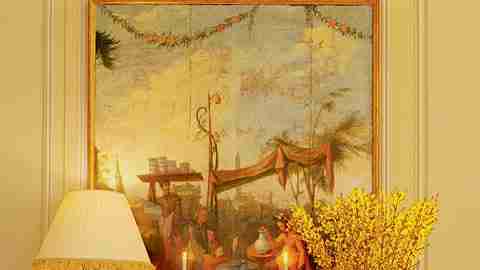View Slideshow

He was a straightarrow venture capitalist, a widower from New York who made his home—a spare, modern house enlivened with the occasional ikebana basket—in Northern California. She was an artist, a Puerto Rico-born divorcée who lived nearby in a Norman-style residence leaning toward tropical hues and majolica. Opposites attracted. Before long the two were shopping for a place to call their own. The first house they were shown was a grand Tuscan-style villa that sat at the end of a long driveway on three oak-studded acres. Though the place was big for them—they had seven children between them, but only one still lived at home—they were smitten.
The couple purchased the Tuscan villa 12 years ago. (This is one Before and After tale with a During.) They held their wedding reception at the house, whose classically proportioned rooms, laid out by Gardner Dailey in the 1930s, suited the occasion perfectly. When they returned from their honeymoon, however, both husband and wife realized that the place required a little attention. It had recently served as a decorator show house, and some of the vestiges were annoying. "A little too much sponge painting," says the wife, diplomatically. "It didn't have that great feeling of a country house in Italy. I wanted something that had a little drama without looking like a set from some wild opera."
"I wanted something that had a little drama without looking like some wild opera," says the wife.
After noticing that his name was attached to virtually every house interior they admired, the couple got in touch with Paul Vincent Wiseman, a San Francisco-based interior designer who knows his drama from his opera. Which is not to say that this job was a simple one. "I don't do houses for people," explains the designer, "I do houses with people." And the people, in this case, stretched his, and his former associate Douglas J. Durkin's, talents. "If he'd had his way, he'd have everything beige and black. And she told me, When you shop for me, put on a headset with salsa music.'"
A Latin beat may or may not have fueled Wiseman's first undertaking, the decoration of the sitting room off the entrance hall; the room's faux-tortoise moldings and lacquered and mother-of-pearl-inlaid furniture do have lots of zip. The entrance leads to a gallery that runs the length of the house, bookended by the living and dining rooms. The husband convinced the wife that his pair of 18th-century Japanese screens were just the ticket for the dining room. The wife, spurred by a tiny red flower in the corner of one of the screens, chose red lacquer for the walls, and Wiseman had them trimmed with gold-leafed molding. Substantial pieces like a carved giltwood chandelier and a Chinese black-and-gold-lacquered center table anchor the large room.
Some time later the wife presented Wiseman with a picture of the entrance hall of the Duke and Duchess of Windsor's Paris house—and Wiseman gave the wife a gilt-bronze-and- faux-marbre staircase. Another source of inspiration was "a really snazzy apartment in New York" that the wife had visited; its "color and wonderful drapes and all kinds of things that seemed to be acquired while traveling" gave rise to the living room. Wiseman used an old red Ushak rug and split up the room (the same size as the dining room) into three cozy seating areas. He set off the contemporary paintings that the husband and wife both love with butter-yellow walls and a cosmopolitan mingling of French, Italian and Chinese antiques.
If it sounds as if the wife was getting the upper hand at this point, she was. No hard feelings, though. "If one person wants yellow and the other wants beige," acknowledges the husband, "you meet in the middle and end up with muddy brown." Husband, designer and house (with its stately dimensions) together tempered the wife's penchant for vivid color. The apricot tones of the master bedroom, for instance, are warm and silky—a mellow backdrop to its Bessarabian rug and selection of Neoclassical pieces.
The husband's zone, not surprisingly, is the subdued library. "The library," Wiseman says, "is the one room we completely redid. It had been one huge room with green wallpaper. We added a fireplace and antiqued-pine paneling and divided the space with columns into a home theater and his home office." The library was the most recent project, but it won't be the last. "It's not over yet," says the husband. "I call it the eight-year lightning campaign."
"A house is something that evolves," his other half parries—and it's hard to argue with that. Indoors and out, the couple entertain often, from fund-raisers to family events. "We celebrate Christmas and Hanukkah, Passover and Easter," says the wife. "It's definitely a home, very loved by all of us."
A happy ending? Not exactly; not yet. Wiseman will soon be putting the final touches on a spacious Balinese-style house the couple have built in Hawaii. "It'll be largely decorated when we move in," says the husband, "but my wife will be sticking things in there until we're both pushing up daisies."
